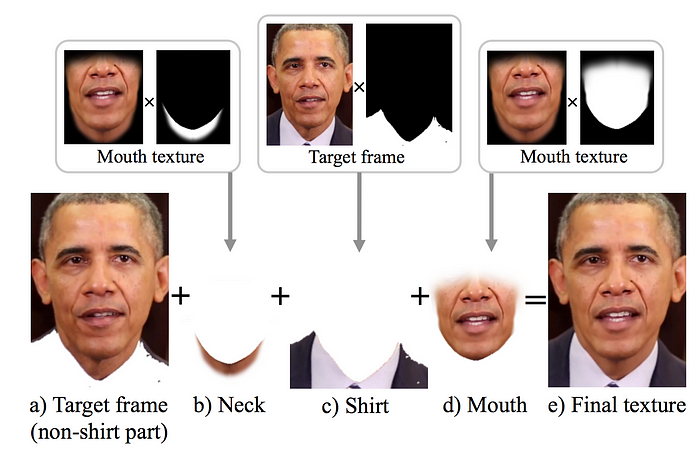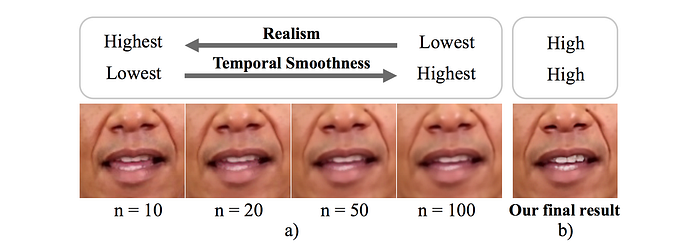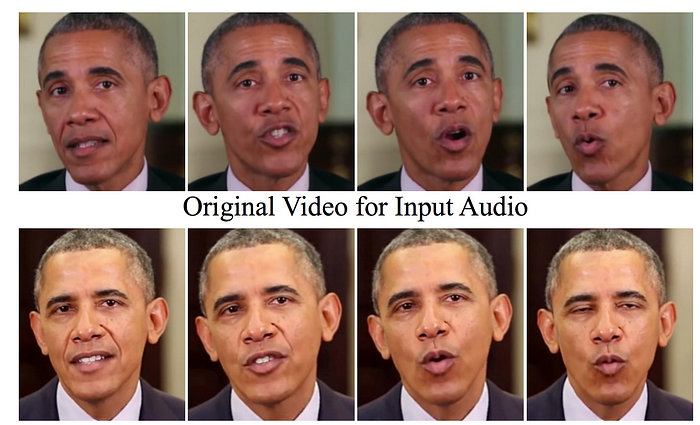How deep learning fakes videos (Deepfake) and how to detect it?
Fabrication of celebrity porn pics is nothing new. However, in late 2017, a user on Reddit named Deepfakes started applying deep learning to fabricate fake videos of celebrities. That starts a new wave of fake videos online. DARPA, as part of the US military, is also funding research in detecting fake videos. Actually, applying AI to create videos started way before Deepfakes. Face2Face and UW’s “synthesizing Obama (learning lip sync from audio)” create fake videos that are even harder to detect. The threat is so real that Jordan Peele created one below to warn the public. This video is created with Adobe After Effects and FakeApp (a Deepfakes application).
In this article, we explain the concept of Deepfakes. We locate some of the difficulties and explain ways to identify fake videos. We also look into research at the University of Washington in creating videos that can lip-sync with potential fake audio.
Note: A more updated and comprehensive series on Deepfakes can be found here.
Basic concept
The concept of Deepfakes is very simple. Let’s say we want to transfer the face of person A to a video of person B.
First, we collect hundreds or thousands of pictures for both persons. We build an encoder to encode all these pictures using a deep learning CNN network. Then we use a decoder to reconstruct the image. This autoencoder (the encoder and the decoder) has over a million parameters but is not even close enough to remember all the pictures. So the encoder needs to extract the most important features to recreate the original input. Think about it as a crime sketch. The features are the descriptions from a witness (encoder) and a composite sketch artist (decoder) uses them to reconstruct a picture of the suspect.
To decode the features, we use separate decoders for person A and person B. Now, we train the encoder and the decoders (using backpropagation) such that the input will match closely with the output. This process is time-consuming. With a GPU graphic card, it takes about 3 days to generate decent results. (after repeat processing images for about 10+ million times)

After the training, we process the video frame-by-frame to swap a person's face with another. Using face detection, we extract the face of person A out and feed it into the encoder. However, instead of feeding to its original decoder, we use the decoder of the person B to reconstruct the picture. i.e. we draw person B with the features of A in the original video. Then we merge the newly created face into the original image.

Intuitively, the encoder is detecting face angle, skin tone, facial expression, lighting and other information that is important to reconstruct the person A. When we use the second decoder to reconstruct the image, we are drawing person B but with the context of A. In the picture below, the reconstructed image has facial characters of Trump while maintaining the facial expression of the target video.


Image
Before the training, we need to prepare thousands of images for both persons. We can take a shortcut and use a face detection library to scrape facial pictures from their videos. Spend significant time to improve the quality of your facial pictures. It impacts your final result significantly.
- Remove any picture frames that contain more than one person.
- Make sure you have an abundance of video footage. Extract facial pictures contain different pose, face angle, and facial expressions.
- Remove any bad quality, tinted, small, bad lighting or occluded facial pictures.
- Some resembling of both persons may help, like similar face shape.

We don’t want our autoencoder to simply remember the training input and replicate the output directly. Remember all possibilities are not feasible. We introduce denoising to introduce data variants and to train an autoencoder to learn smartly. The term denoising may be misleading. The main concept is to distort some information but we expect the autoencoder smartly ignores this minor abnormality and recreates the original. i.e. let’s remember what is important and ignore the un-necessary variants. By repeating the training many times, the information noise will cancel each other and eventually forgotten. What is left is the real patterns that we care about.
In our facial picture, we select 5 × 5 grid points and shift them slightly away from their original positions. We use a simple algorithm to warp the image according to those shifted grid points. Even the warped image may not look exactly right, but that is the noise that we want to introduce. Then we use a more complex algorithm to construct a target image using the shifted grid points. We want our created images to look as close as the target images.

It seems odd but that forces the autoencoder to learn the most important features.

To handle different pose, facial angles and locations better, we also apply image augmentation to enrich the training data. During training, we rotate, zoom, translate and flip our facial image randomly within a specific range.
Deep network model
Let’s take a short break to illustrate how the autoencoder may look like. (Some basic knowledge of CNN is needed here.) The encoder composes of 5 convolution layers to extract features followed by 2 dense layers. Then it uses a convolution layer to upsampling the image. The decoder continues the upsampling with 4 more convolution layers until it reconstructs the 64 × 64 image back.

To upsample the spatial dimension say from 16 × 16 to 32 × 32, we use a convolution filter (a 3 × 3 × 256 × 512 filter) to map the (16, 16, 256) layer into (16, 16, 512). Then we reshape it to (32, 32, 128).
Problems
Don’t get too excited. If you use a bad implementation, a bad configuration or your model is not properly trained, you will get the result of the following video instead. (Check out the first few seconds. I have marked the video around 3:37 already.)
The facial area is flicking, blur with bleeding color. And there are obvious boxes around the face. It looks like people pasting pictures onto his face by brute force. These problems are easily understood if we explain how to swap face manually.
We start with two pictures (1 and 2) for 2 women. In picture 4, we try to paste the face 1 onto 2. We realize that their face is very different and the face cutout (the red rectangle) is way too big. It just looks like someone put a paper mask on her. Now, let’s try to paste face 2 onto 1 instead. In picture 3, we use a smaller cutout. We create a mask that removes some of the corner areas so the cutout can blend in better. It is not great but definitely better than 4. But there is a sudden change in skin tone around the boundary area. In picture 5, we reduce the opacity of the mask around the boundary so the created face can blend in better. But the color tone and the brightness of the cutout still does not match the target. So in picture 6, we adjust the color tone and the brightness of the cutout to match our target. It is not good enough yet but not bad for our tiny effort.

In Deepfakes, it creates a mask on the created face so it can blend in with the target video. To further eliminate the artifacts, we can
- apply a Gaussian filter to further diffuse the mask boundary area,
- configure the application to expand or contract the mask further, or
- control the shape of the mask.

If you look closer to a fake video, you may notice double chins or ghost edges around the face. That is the side effect of merging 2 images together using a mask. Even the mask improves the quality, there is a price to pay. In particular, most fake videos I see, the face is a little bit bury comparing with other parts of the image. To counterbalance it, we can configure Deepfakes to apply a sharpen filter to the created face before the blending. This is a trial and error process to find the right balance between artifacts and sharpness. Obviously, most of the time, we need to create slightly blur images to remove noticeable artifacts.
Even the autoencoder should create faces to match the target color tone, sometimes it needs help. Deepfakes provides post-processing to adjust the color tone, contrast and brightness of the created face to match the target video. We can also apply the cv2 seamless cloning to blend the created image with the target image using automatic tone adjustment. However, some of these efforts can be counterproductive. We can make a particular frame looks great. But if we overdo it, it may hurt the temporal smoothness across frames. Indeed, the seamless clone in Deepfakes is a major possible cause of flicking. So people often turn seamless off to see if the flicking can be reduced.
Another major source of flicking is the autoencoder fails to create proper faces. For that, we need to add more diversify images to train the model better or increase the data augmentation. Eventually, we may need to train the model longer. In cases where we cannot create the proper face for some video frames, we skip the problem frames and use interpolation to recreate the deleted frames.
Landmarks
We can also warp our created face according to the face landmarks in the original target frame.

This is how Rogue One warp the younger Princess Leia face onto another actress.

Better mask
In our previous effort, our mask is pre-configured. We can do a much better job if our mask is related to the input image and the created face.

Let’s introduce Generative Adversary Networks (GAN).
GAN
In GAN, we introduce a deep network discriminator (a CNN classifier) to distinguish whether facial images are original or created by the computer. When we feed real images to this discriminator, we train the discriminator itself to recognize real images better. When we feed created images into the discriminator, we use it to train our autoencoder to create more realistic images. We turn this into a race that eventually the created images are not distinguishable from the real ones.
In addition, our decoder generates images as well as masks. Since these masks are learned from the training data, it can mask the image better and create a smoother transition to the target image. Also, it handles partially obstructed faces better. In many fake videos, when the face is partially blocked by a hand, the video may flick or turn bury. With a better mask, we can mask out the obstructed area in the created face and use the part in the target image instead.

Even though GAN is powerful, it takes very long to train and require higher level of expertise to make it right. Therefore, it is not as popular as it should be.
Loss function
Besides the reconstruction cost, GAN adds a generator and discriminator cost to train the model. Indeed, we can add addition loss functions to perfect our model. One common one is the edge cost which measures whether the target image and the created image have the same edge at the same location. Some people also look into the perceptual loss. The reconstruction cost measures the pixel difference between the target image and the created image. However, this may not be a good metric in measuring how our brains perceive objects. Therefore, some people may use perception loss to replace the original reconstruction loss. This is pretty advanced so I will let those enthusiasts read the paper in the reference section instead. You can further analyze where your fake videos perform badly and introduce a new cost function to address the problem.
Demonstration
Let me pick some of the good Deepfakes videos and see whether you can detect them now. Play it in slow motion and pay special attention to:
- Does it over blur comparing with other non-facial areas of the video?
- Does it flick?
- Does it have a change of skin tone near the edge of the face?
- Does it have a double chin, double eyebrows, double edges on the face?
- When the face is partially blocked by hands or other things, does it flick or get blurry?
In making fake videos, we apply different loss functions to make more visual pleasant videos. As shown in the Trump fake pictures, the features of his face look close to the real one but it does change if you look closer. Hence, in my opinion, if we feed the target video into a classifier for identification, there is a good chance that it will fail. In addition, we can write programs to verify the temporal smoothness. Since we create faces independently across frames, we should expect the transition to be less smooth compared to a real video.
Lip sync from audio
The video made by Jordan Peele is one of the toughest ones to be identified as fake. But once you look closer, the lower lip of Obama is more blurry comparing with other parts of the face. Therefore, instead of swapping out the face, I suspect this is a real Obama video but the mouth is fabricated to lip-sync with fake audio.
For the rest of this section, we will discuss the lip-sync technology done at the University of Washington (UW). Below is the workflow of the lip sync paper. It substitutes the audio of a weekly presidential address with another audio (input audio). In the process, it re-synthesizes the mouth and the chin area so its movement is in-sync with the fake audio.

First, using an LSTM network, the audio x is transformed into a sequence of 18 landmark points y in the lip. This LSTM outputs a sparse mouth shape for each output video frame.

Given the mouth shape y, it synthesizes mouth texture for the mouth and the chin area. These mouth textures are then composed with the target video to recreate the target frame:

So how do we create the mouth texture? We want it to look real but also have a temporal smoothness. So the application looks over the target videos to search for candidates' frames that have the same calculated mouth shape as what we want. Then we merge the candidates together using a median function. As shown below, if we use more candidate frames to do the averaging, the image gets blurred while the temporal smoothness improves (no flicking). On the other hand, the image can be less bury but we may see flicking when transiting from one frame to another.

To compensate for the blurry, teeth enhancement and sharpening is performed. But obviously, the sharpness cannot be completely restored for the lower lip.

Finally, we need to retime the frame so we know where to insert the fake mouth texture. This helps us to sync with the head movement. In particular, Obama's head usually stops moving when he pauses his speech.

The top row below is the original video frames for the input audio we used. We insert this input audio to our target video (the second row). When compare it side-by-side, we realize the mouth movement from the original video is very close to the fabricated mouth movement.

UW uses existing frames to create the mouth texture. Instead, we can use the Deepfakes concept to generate the mouth texture directly from the autoencoder. We need to collect thousands of frames and use the LSTM to extract the features from both the video and the audio. Then we can train a decoder to generate the mouth texture.
More thoughts
It is particularly interesting to see how we apply AI concepts to create new ideas and new products, but not without a warning! The social impacts can be huge. In fact, do not publish any fake videos for fun! It can get you into legal troubles and hurt your online reputation. I look into this topic because of my interest in meta-learning and adversary detections. Better use your energy for things that are more innovative. On the other hand, fake videos will stay and be improved. It is not my purpose to make better fake videos. Through this process, I hope we know how to apply GAN better to reconstruct an image. Maybe one day, this may eventually helpful in detecting tumors.
As another precaution, be careful about the Apps that you download to create Deepfakes videos. There are reports that some Apps hijack computers to mine cryptocurrency. Just be careful.
Listing of other articles
Reference
Synthesizing Obama: Learning Lip Sync from Audio
Credits
Photo credits (Head scarf)
